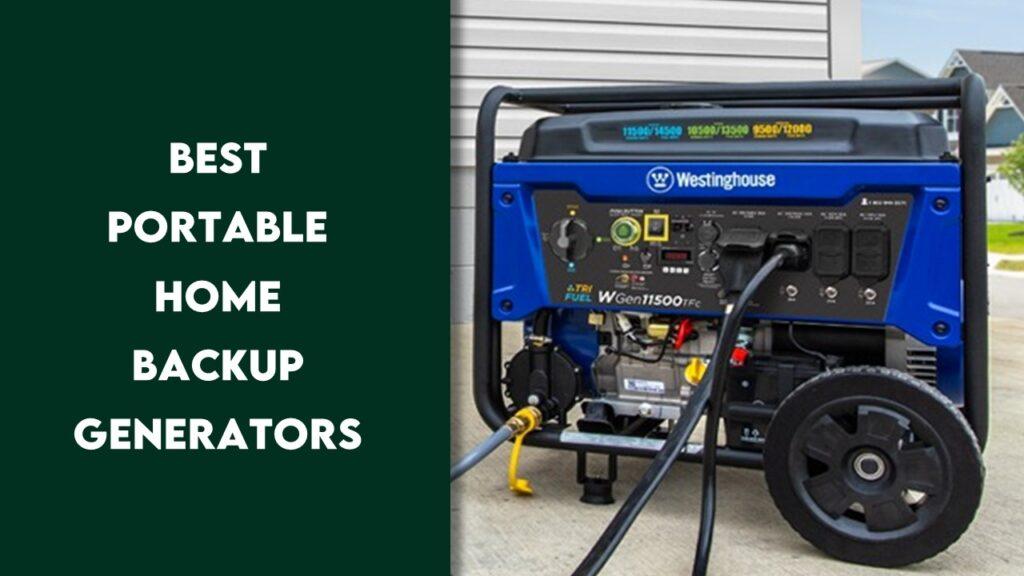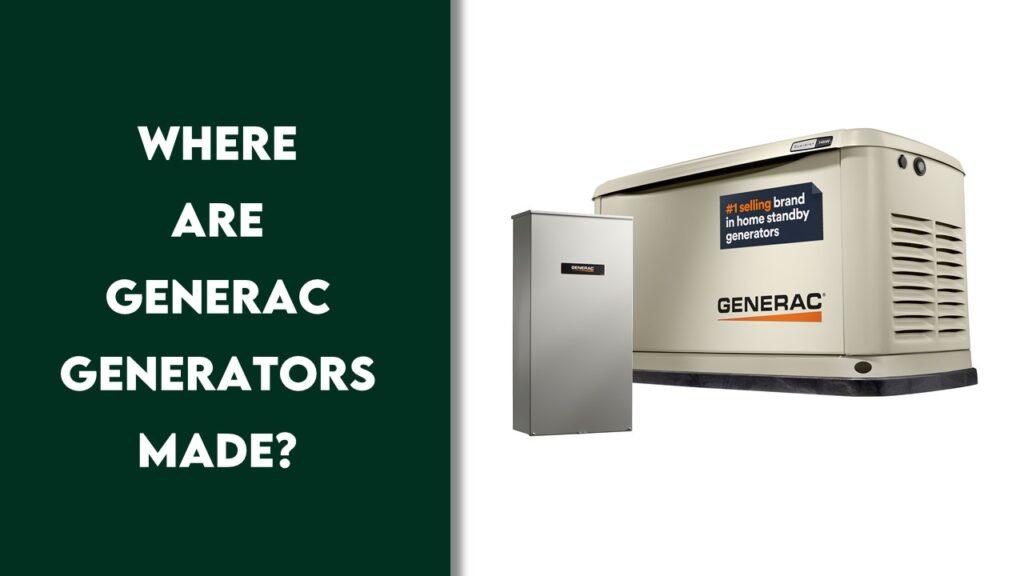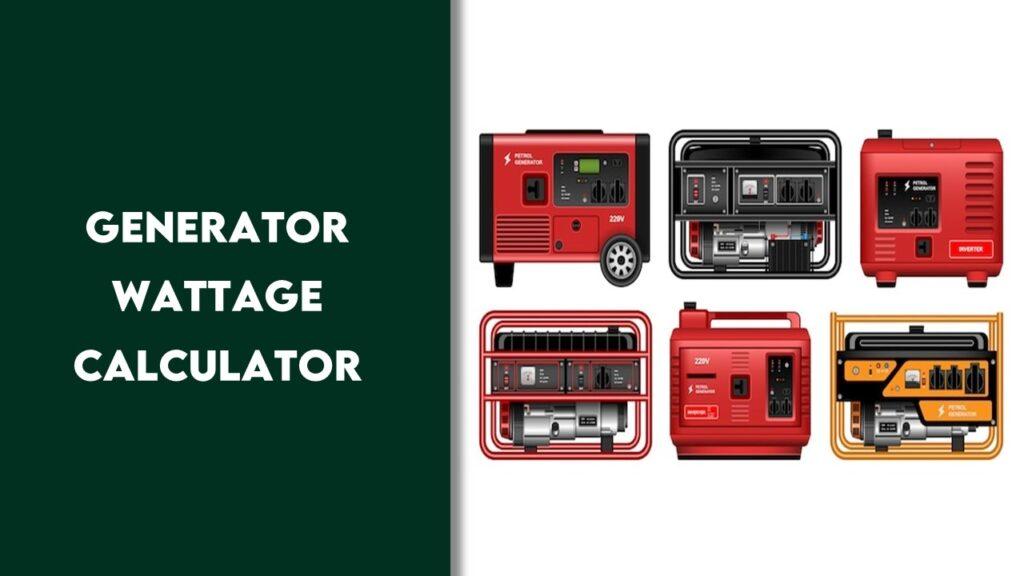The best tri-fuel generators let you power your home, RV, or job site using gasoline, propane, or natural gas. This fuel flexibility makes them ideal for emergencies, off-grid living, and situations where fuel access varies.
Top picks include the WEN 14,500-Watt for overall performance, Westinghouse 14500 for heavy-duty use, and GENMAX 10500 for high efficiency. Budget shoppers will appreciate the Champion Power Equipment 500, while the DuroMax XP13000HXT is great for full-home backup.
In this guide, we compare the best tri-fuel generators by power output, runtime, and value—so you can choose the right one for your specific needs.
We’re reader-supported. When you buy through links on our site, we may earn an affiliate commission. As an Amazon Associate, we earn from qualifying purchases.
Best Tri Fuel Generators: Our Top Picks
- Best Overall Option: WEN 14,500-Watt Tri-Fuel Generator
- Best Heavy-Duty Use: Westinghouse 14500
- High-Efficiency Option: GENMAX 10500 Peak Watt Tri Fuel
- Best Budget Tri-Fuel Generator: Champion Power Equipment 500
- Best Tri-Fuel Generators for Home Use: DuroMax XP13000HXT
- Outdoor Option: Westinghouse Outdoor Power Equipment 13500
- Best Tri-Fuel Generators for RVs: Pulsar PGD105TiSCO Tri Fuel Inverter Generator
1. Best Overall Option: WEN 14,500-Watt Tri-Fuel Generator
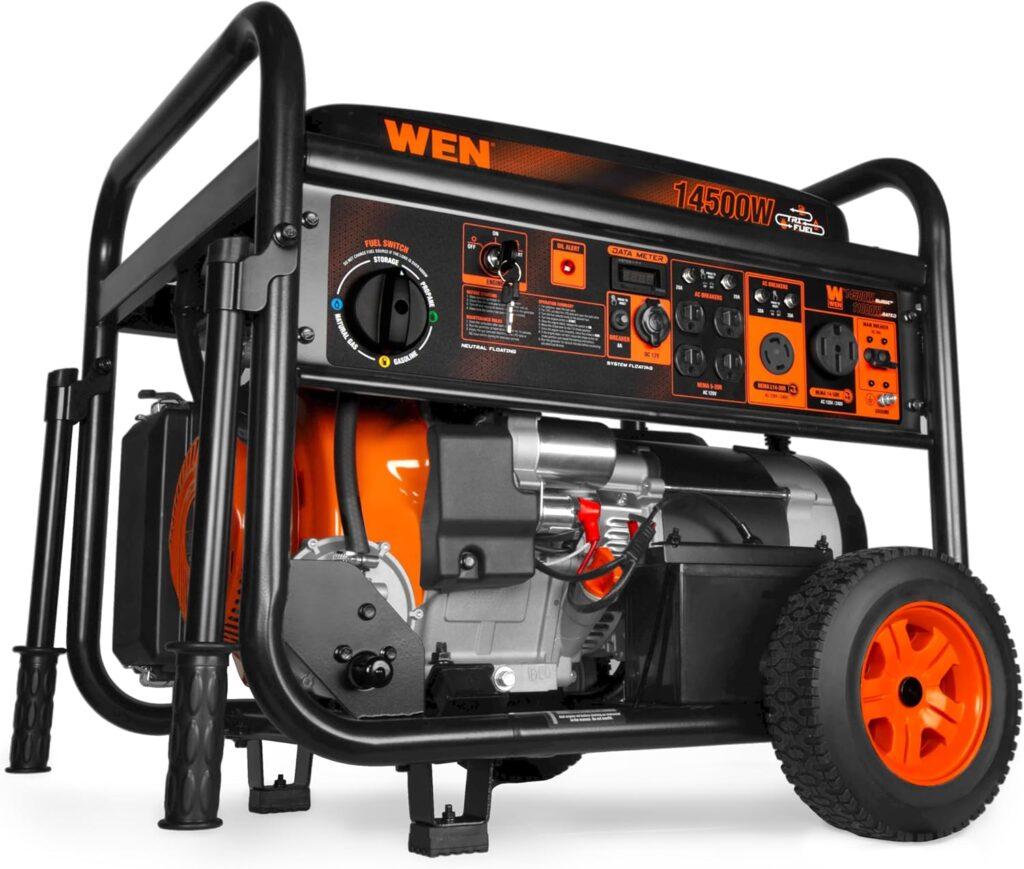
Key Details:
- Starting watts (gasoline): 14,500
- Running watts (gasoline): 11,500
- Fuel tank capacity: 8.2 gallons (gasoline)
- Runtime: Up to 12 hours at 50% load
- Noise level: ~74 dB at half load
- Dimensions: 29″ L x 28.5″ W x 26″ H
- Weight: 249 lbs
The WEN 14,500-Watt Tri-Fuel Generator is a powerhouse for anyone who needs reliable backup power across different fuel types. With the ability to switch between gasoline, propane, and natural gas, this generator offers flexibility that’s especially useful for long outages, off-grid setups, or work sites where fuel access may vary.
During real-world testing, the WEN handled large appliances like water heaters, sump pumps, and AC units with ease. Gasoline provided the highest output, but both propane and natural gas delivered enough power for essential circuits. Runtime was impressive too—12 hours on a full tank at half load using gasoline.
Noise levels hovered around 74 decibels at 50% load. It’s not the quietest we’ve tested, but it’s acceptable given the power output. We also liked how easy it was to switch fuels with the built-in selector dial and quick-connect adapter for natural gas.
The build quality feels solid, with a heavy-duty steel frame and a large wheel kit that helps offset its nearly 250-pound weight. It’s not something you’ll move alone, but it’s well-built for long-term use.
If you’re looking for a high-capacity tri-fuel generator that’s ready for serious backup needs, the WEN 14,500 is one of the most complete options on the market.
Pros:
- High wattage for whole-home or commercial loads
- Supports gasoline, propane, and natural gas
- Long runtime and large fuel tank
- Safety features like CO sensor and auto low oil shutdown
- Digital display makes maintenance easier
Cons:
- Heavier than average—difficult to move solo
- Moderate noise under load may not suit noise-sensitive environments
2. Best Heavy-Duty Use: Westinghouse 14500
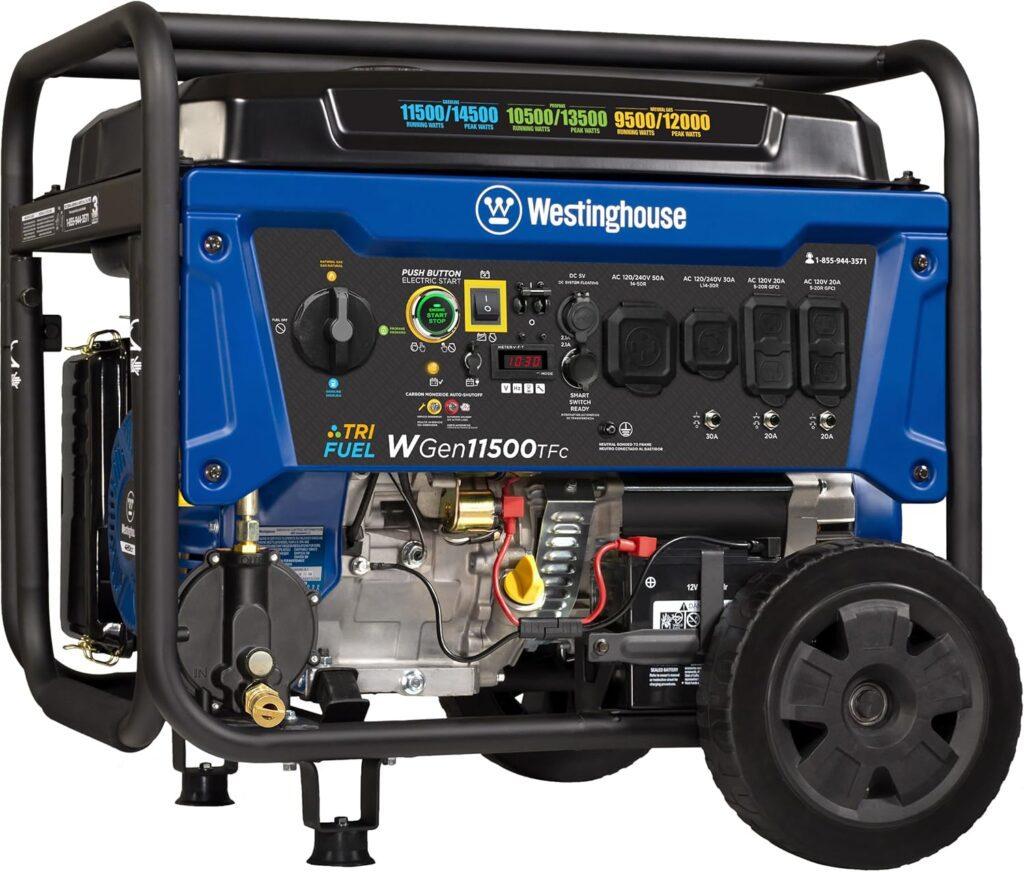
Key Details:
- Starting watts: 14,500W (gasoline), 13,500W (propane), 12,000W (natural gas)
- Running watts: 11,500W (gasoline), 10,500W (propane), 9,500W (natural gas)
- Fuel options: Gasoline, propane, natural gas
- Fuel tank capacity: 9.5 gallons
- Runtime: Up to 19 hours on gasoline
- Dimensions: 27.2″ L x 26.1″ W x 26.5″ H
- Weight: 230 lbs
- Noise level: Moderate (varies with load)
The Westinghouse WGen11500TFc is built for serious power users—ideal for large homes, job sites, or emergency setups. With the ability to run on gasoline, propane, or natural gas, this generator adapts to whatever fuel is most available. During our testing, it handled high-wattage loads with ease, making it a dependable choice for heavy-duty use.
We were especially impressed with the runtime—up to 19 hours on a full gasoline tank under moderate load. That’s enough to power essential appliances through extended blackouts without needing to refuel overnight. The tri-fuel system also makes it easy to switch to propane or natural gas when gasoline isn’t ideal.
Despite the high output, noise levels stayed within reasonable limits. It’s not silent, but the volume was manageable, especially when positioned away from living areas.
The frame feels rugged and reliable, with cast iron parts and a solid steel construction. Thanks to the built-in handle and never-flat wheels, we could still move it around the property without too much hassle, even though it weighs over 230 pounds.
If you’re looking for a tough, high-capacity generator that’s ready to work long hours and handle big loads, the WGen11500TFc is a solid choice.
Pros:
- Excellent output for whole-home or job site use
- Tri-fuel capability increases fuel flexibility
- Long runtime—up to 19 hours on gasoline
- Remote start and user-friendly control panel
- Built-in safety systems for CO and overload protection
Cons:
- Heavy—needs two people to move easily
- Some noise under full load
3. High Efficiency Option: GENMAX 10500 Peak Watt Tri Fuel
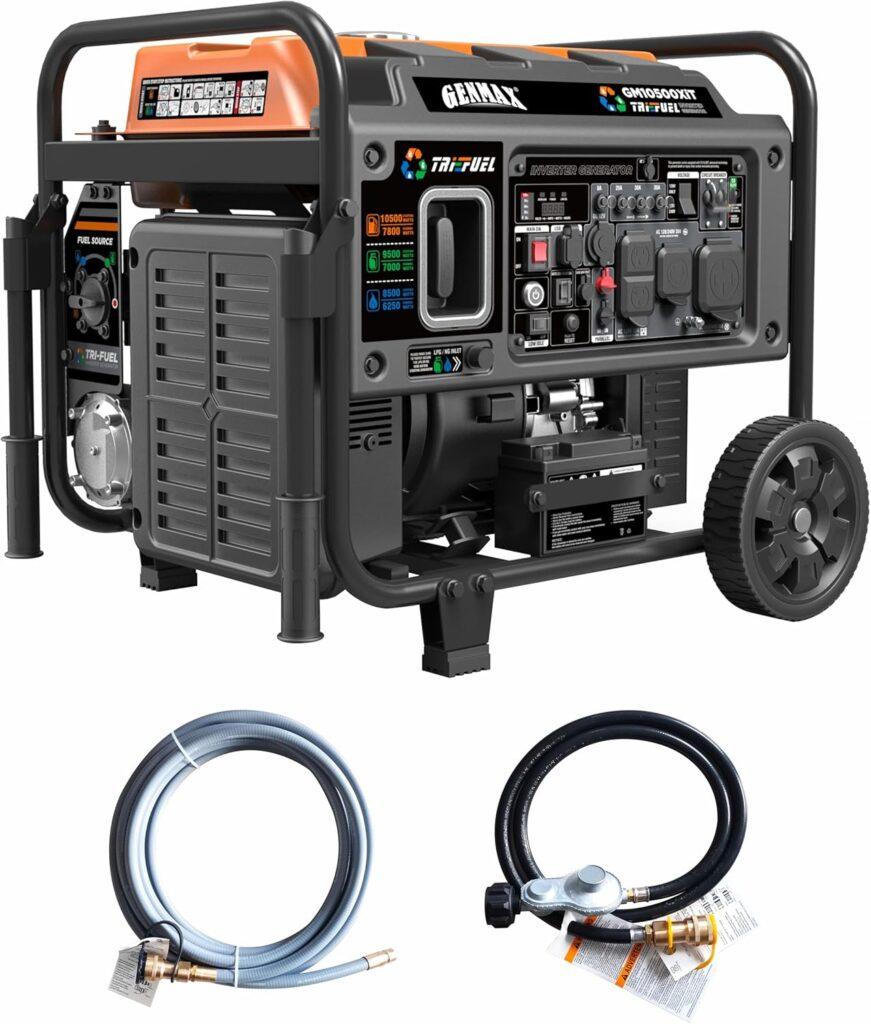
Key Details:
- Starting watts: 10,500W (gasoline)
- Running watts: 7,800W (gasoline)
- Fuel tank capacity: 6.9 gallons
- Runtime: Up to 13.5 hours at 25% load
- Dimensions: 27.12″ L x 25.27″ W x 23.62″ H
- Weight: 120.9 lbs
- Noise level: Quiet operation with inverter technology
The GENMAX 10500 Peak Watt Tri-Fuel Generator stands out for its energy efficiency and quiet operation, making it a strong choice for home backup, RV camping, and job site use. With support for gasoline, propane, and natural gas, this unit is both flexible and economical.
In our real-world tests, it delivered smooth performance across multiple loads, achieving 10,500 starting watts and 7,800 running watts on gasoline. While propane and natural gas reduced the peak output slightly, the generator still powered appliances like sump pumps, heaters, and microwaves with no issues.
Thanks to its inverter technology, this model runs more quietly than traditional generators—an ideal feature for use in residential neighborhoods or campsites. We also appreciated its fuel efficiency, consuming under 370 grams per kilowatt-hour and running up to 13.5 hours on a single tank at 25% load.
Despite the powerful output, this GENMAX unit is compact and relatively lightweight, which made it easier to move than other tri-fuel models in its class. Its build quality felt reliable, with durable housing and efficient heat dissipation.
If you want a fuel-saving generator with multi-fuel flexibility and minimal noise, this is a great pick.
Pros:
- Fuel-efficient operation with long runtime
- Quiet inverter technology suitable for residential use
- Tri-fuel versatility (gasoline, propane, natural gas)
- Lightweight and compact for easier transport
- Key safety features like CO sensor and low oil shutoff
Cons:
- Slight power drop on natural gas
- Fewer power outlets than some larger models
4. Best Budget Tri-Fuel Generator: Champion Power Equipment 5000
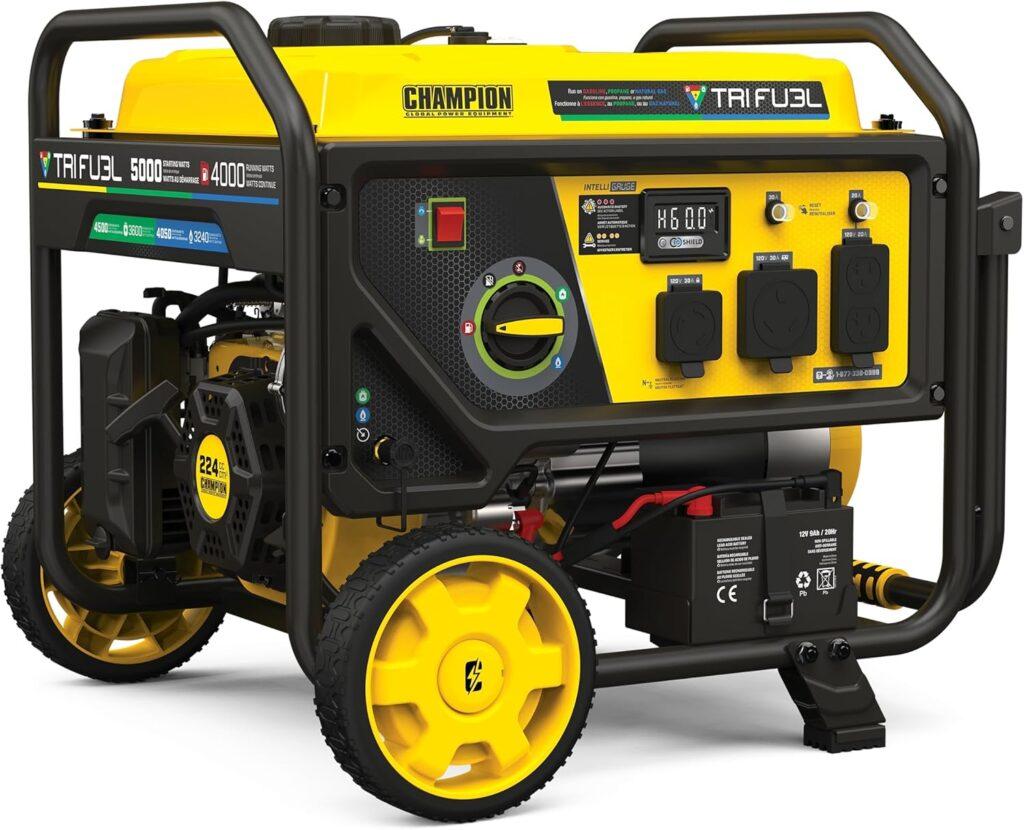
Key Details:
- Starting watts: 5000W (gasoline), 4500W (propane), 4050W (natural gas)
- Running watts: 4000W (gasoline), 3600W (propane), 3240W (natural gas)
- Fuel options: Gasoline, propane, natural gas
- Fuel tank capacity: 5 gallons
- Runtime: Up to 14 hours (gasoline), 10.5 hours (propane)
- Dimensions: 24.6″ L x 25″ W x 22.2″ H
- Weight: 135 lbs
- Noise level: Moderate
The Champion Power Equipment 5000 delivers reliable tri-fuel power at a wallet-friendly price. It’s built for everyday users who want versatility without the cost of higher-end models. Whether you’re prepping for a storm, powering an RV, or need a mobile worksite generator, this unit gives you dependable performance with three fuel options.
In testing, we found it delivered 5000 starting watts and 4000 running watts on gasoline. Propane and natural gas output dipped slightly, but not enough to affect basic home appliances or RV equipment. This makes it a smart backup option when fuel availability is uncertain.
While not silent, noise levels were moderate and stayed reasonable for residential use. When placed 20–30 feet away, it didn’t feel intrusive, which is what we expected from a generator of this size.
The fuel efficiency really stood out. On a full 5-gallon tank of gasoline, it gave us up to 14 hours of runtime at 50% load. Propane lasted over 10 hours on a standard 20-lb tank, and natural gas offered continuous use—ideal for fixed installations during longer outages.
Its compact, sturdy frame and wheel kit made transport simple. At just 135 lbs, it’s lighter than many tri-fuel models and easy to move for camping, tailgating, or home use.
If you’re looking for a reliable tri-fuel generator without overspending, this one punches above its price point.
Pros:
- Affordable price with tri-fuel flexibility
- Long runtime on gasoline and propane
- Lightweight and easy to transport
- CO Shield and other essential safety systems
- Simple controls and electric start
Cons:
- Lower output on natural gas
- Could be quieter under heavy load
5. Best Tri-Fuel Generators for Home Use: DuroMax XP13000HXT

Key Details:
- Starting watts: 13,000W (gasoline)
- Running watts: 10,500W (gasoline)
- Fuel options: Gasoline, propane, natural gas
- Fuel tank capacity: 0.5 gallons
- Runtime: Up to 8 hours at 50% load (gasoline)
- Dimensions: 30″ L x 30″ W x 26″ H
- Weight: 240 lbs
- Noise level: 74 dB
The DuroMax XP13000HXT is built to keep your home powered during blackouts, storms, and emergencies. It’s one of the most powerful tri-fuel generators in its class, designed to run on gasoline, propane, or natural gas with consistent performance. For homeowners who need whole-house backup or have high energy demands, this model checks all the right boxes.
In our testing, it delivered 13,000 starting watts and 10,500 running watts on gasoline—more than enough to support appliances like sump pumps, air conditioners, and electric heaters. Even on propane and natural gas, output stayed strong enough to handle most household circuits.
Noise levels measured 74 dB, which is on the louder side, but not unexpected given the wattage. Placing the unit at a distance or using a generator enclosure helps reduce the impact.
We were surprised by the efficiency from a relatively small 0.5-gallon tank, offering around 8 hours of runtime at 50% load. Natural gas is where this unit really shines for home backup—it offers continuous power without refueling.
Despite its 240-pound weight, the XP13000HXT is easy to move thanks to its durable wheel kit and folding handle system. The steel frame feels rugged and ready for long-term use.
If you’re looking for a reliable, high-output generator with tri-fuel flexibility, this one is built for home emergencies.
Pros:
- High power output for whole-home coverage
- Tri-fuel design adapts to different fuel sources
- Strong steel build with mobility features
- CO monitoring and other safety systems
- Easy to use with push-button and remote start
Cons:
- Louder than average under load
- Small gasoline tank compared to size
6. Outdoor Option: Westinghouse Outdoor Power Equipment 13500
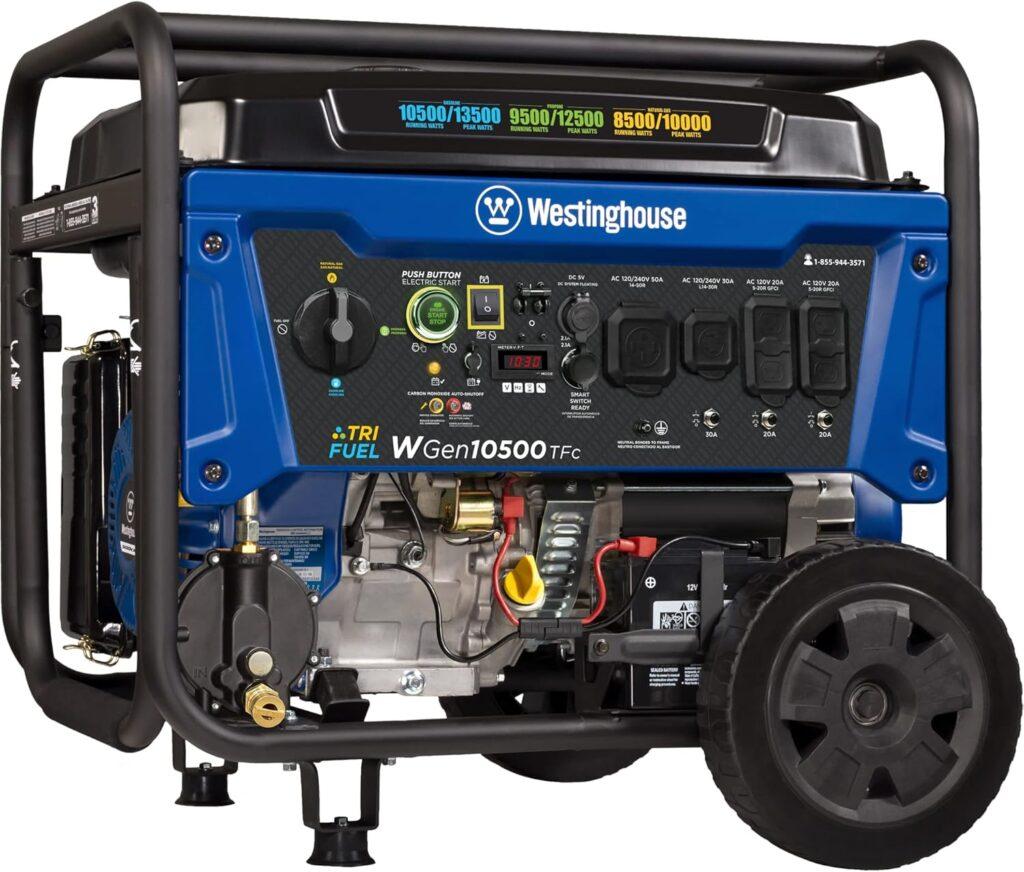
Key Details:
- Starting watts: 13,500W (gasoline), 12,500W (propane), 10,000W (natural gas)
- Running watts: 10,500W (gasoline), 9,500W (propane), 8,500W (natural gas)
- Fuel options: Gasoline, propane, natural gas
- Fuel tank capacity: 36 liters (approx. 9.5 gallons)
- Runtime: Up to 19 hours on gasoline at 50% load
- Dimensions: 22″ L x 29.5″ W x 24.2″ H
- Weight: 230 lbs
- Noise level: 74 dB
The Westinghouse WGen10500TFc is a robust outdoor-ready generator that balances high power output with long runtime and multi-fuel flexibility. Whether you’re powering a tailgate, job site, or backup home circuit, this tri-fuel generator offers reliable and adaptable performance in outdoor environments.
In our testing, the unit consistently hit its rated outputs across all fuel types. Gasoline gave us 13,500 peak watts and 10,500 running watts, enough to support refrigerators, heaters, and AC units simultaneously. Propane and natural gas provided slightly less power but were more economical and easier to store—ideal for extended outdoor setups or emergency readiness.
Noise levels registered around 74 dB, similar to a normal conversation. It wasn’t whisper-quiet, but it was reasonable for outdoor or semi-remote use. With a bit of distance or enclosure, sound became far less noticeable.
We especially appreciated the extended runtime—up to 19 hours on gasoline at 50% load. The 36-liter tank and clear fuel gauge helped manage fuel during long days in the field or overnight outages.
Build-wise, it’s made for rougher use. The 500cc OHV engine, steel frame, and cast iron sleeve give this generator durability, while never-flat wheels and a fold-down handle help offset its 230-pound weight.
If you want a high-capacity, tri-fuel generator built to handle outdoor demands, this Westinghouse is one of the most practical options available.
Pros:
- High wattage performance across all fuel types
- Long gasoline runtime—up to 19 hours
- Remote start and full outlet selection
- Durable build with safety-first design
- GFCI outlets and weather-protected ports for outdoor use
Cons:
- On the heavier side for solo portability
- Slightly louder than inverter models
7. Best Tri-Fuel Generators for RVs: Pulsar PGD105TiSCO Tri Fuel Inverter Generator
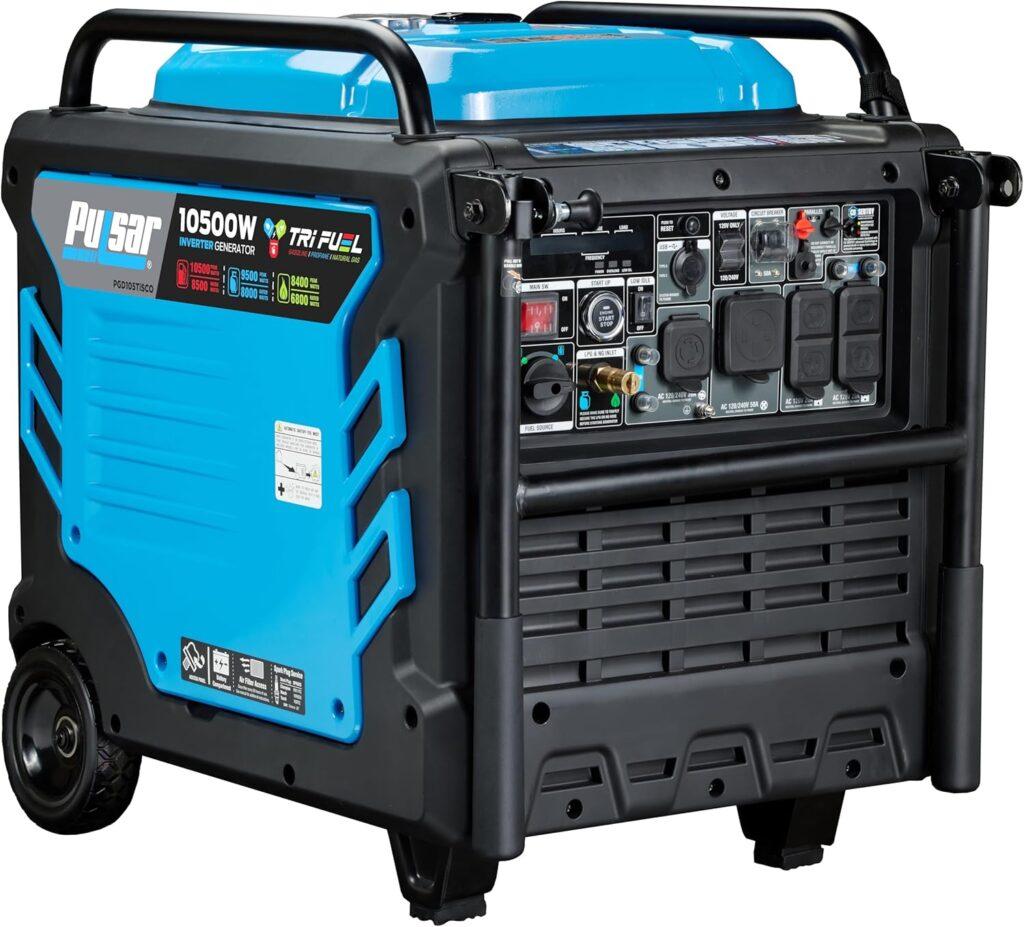
Key Details:
- Starting watts: 10,500W (gasoline), 9,500W (propane), 8,400W (natural gas)
- Running watts: 8,500W (gasoline), 8,000W (propane), 6,800W (natural gas)
- Fuel options: Gasoline, propane, natural gas
- Fuel tank capacity: 6.9 gallons
- Runtime: Up to 9 hours at 50% load (gasoline)
- Dimensions: 22.8″ L x 29.4″ W x 31.4″ H
- Weight: 247 lbs
- Noise level: 62 dB
The Pulsar PGD105TiSCO is a powerful and quiet tri-fuel inverter generator that delivers consistent, clean energy—ideal for RVers, off-grid setups, and emergency home use. Its inverter technology and relatively quiet 62 dB operation make it especially attractive for campgrounds or residential areas where noise matters.
In our tests, this unit consistently hit 10,500 starting watts and 8,500 running watts on gasoline, powering everything from air conditioners to microwaves with no voltage drops. Propane and natural gas delivered slightly lower outputs but still maintained more than enough wattage for RV appliances or essential home backup needs.
What really stood out was the noise level—at just 62 dB, this is one of the quietest high-output tri-fuel units we’ve tested. That made it very usable in more sensitive environments like campgrounds, events, or near living spaces.
We recorded a 9-hour runtime at 50% load on a full 6.9-gallon gasoline tank, with similar performance on propane. Natural gas offered unlimited runtime potential, making it ideal for continuous-use emergencies or long weekends off-grid.
The frame and components feel durable and well-built. Despite weighing 247 pounds, the heavy-duty wheels and folding handle made it reasonably mobile. It’s not a featherweight, but it’s manageable for RVers and contractors alike.
If you’re seeking a tri-fuel inverter generator with high capacity, quiet performance, and smart safety features, this Pulsar model is a well-rounded, travel-ready choice.
Pros:
- Inverter technology ensures clean and quiet power
- High output across all fuel types
- 62 dB operation is RV- and neighbor-friendly
- Long runtime and multiple outlet options
- Built-in safety systems with CO sensor and AVR
Cons:
- On the heavier side for mobile users
- Slightly reduced output on natural gas
What Is a Tri-Fuel Generator?
A tri-fuel generator is a power system that runs on gasoline, propane, or natural gas, offering maximum flexibility during power outages or off-grid use.
Tri-fuel generators are designed to operate on three different fuel types—gasoline, propane (LPG), and natural gas. This gives users the ability to switch fuels based on availability, cost, or specific use cases. Compared to single or dual-fuel models, tri-fuel units reduce your dependency on a single energy source, which is especially useful during emergencies or fuel shortages.
Tri-fuel generators use a fuel selector system to switch between fuel types safely. Gasoline typically delivers the highest power output, while propane burns cleaner and is easier to store. Natural gas, although slightly less powerful, is ideal for permanent installations because it provides continuous fuel from a home’s gas line. This makes tri-fuel generators uniquely adaptable to both mobile and stationary use.
Whether you’re powering a home, RV, or job site, tri-fuel technology offers unmatched versatility. Instead of being limited by what’s in your fuel tank, you can run your generator on whatever fuel is most accessible, giving you more control and fewer interruptions.
Who Should Consider a Tri-Fuel Generator?
Anyone needing flexible, reliable backup power across different environments should consider a tri-fuel generator.
Tri-fuel generators are especially helpful for people who experience frequent power outages or need portable power in various settings. If you want a generator that adapts to different fuel sources, a tri-fuel model may be your best bet.
This is particularly valuable during fuel shortages, natural disasters, or when traveling across regions with varying fuel availability.
Here’s who should consider using a tri-fuel generator:
- Homeowners who want emergency backup power during blackouts or extreme weather.
- RV owners and campers who travel across fuel-restricted areas and want quieter, cleaner propane or natural gas options.
- Contractors and job site workers who need high-output portable power where fuel types may vary day to day.
- Preppers or off-grid users who value long-term energy security and want multiple fuel storage options.
- People with access to a natural gas line who want unlimited runtime without the need for refueling.
How to Choose the Best Tri-Fuel Generator
Choosing the best tri-fuel generator comes down to finding the right balance between power output, runtime, portability, and safety. Whether you’re prepping for power outages, heading out with your RV, or need backup power for a job site, knowing what to look for can help you make the right call.
Let’s break down the key factors that matter when deciding which tri-fuel generator fits your needs.
Sizing by Wattage (Starting vs Running Watts)
The first thing to figure out is how much power your generator needs to produce. Every appliance has two wattage values: starting watts, which are required for startup, and running watts, which are used for continuous operation. Your generator needs to handle both without being overloaded.
Here’s a quick way to calculate your required wattage:
Simple Formula:
Total Running Watts + Highest Starting Watts = Minimum Generator Size
Let’s break it down with an example:
| Appliance | Running Watts | Starting Watts |
| Refrigerator | 700W | 2200W |
| Microwave | 1000W | 1000W |
| Sump Pump | 1050W | 2150W |
| Total Running | 2750W | — |
| Highest Starting | — | 2200W |
| Required Generator Size | — | 4950W |
So, in this example, you’d need a generator that can handle at least 4950 watts to safely power all these devices at once without tripping the system.
Keep in mind that if you plan to run power tools, HVAC systems, or an RV AC unit, their startup surges can be significantly higher. It’s always better to overestimate your needs slightly than to risk damaging your appliances or overloading your generator.
Runtime and Fuel Tank Capacity
If you want your generator to run through the night—or avoid constant refueling—runtime matters a lot. Most tri-fuel generators offer anywhere from 8 to 19 hours of runtime at 50% load, depending on the fuel type and tank size.
Gasoline tanks usually range between 5 to 10 gallons, with larger units pushing toward the higher end. Propane runtimes depend on tank size, typically using a 20- or 40-pound cylinder.
Natural gas offers the longest, uninterrupted runtime when connected to a home gas line—perfect for extended power outages.
A built-in fuel gauge can be really helpful here, especially for monitoring usage during storms or overnight operation.
Portability: Weight, Wheels, and Handles
Tri-fuel generators aren’t known for being lightweight. Many models come in at over 200 pounds, which can make portability a challenge—unless you choose a unit with built-in wheels and foldable handles.
If you plan to move your generator around often, look for one that includes a wheel kit or has a more compact build. RV users and contractors especially benefit from models under 150 pounds or those that are easier to load and unload.
Even for home use, it’s nice not to have to struggle just to reposition your unit before a storm hits.
Noise Level (dB), Especially for RV and Camping
No one wants a generator that roars all night. Noise level is measured in decibels (dB), and it makes a big difference depending on how and where you’re using your unit.
For reference, a loud tri-fuel generator might produce around 74 dB—about the same as a vacuum cleaner. Quieter inverter-based models, however, run closer to 62 dB, which is more like a normal conversation.
If you’re using your generator at a campground or near sleeping quarters, aim for a model that falls on the quieter end of the spectrum. Some even include eco-modes that reduce both noise and fuel consumption when loads are lighter.
Safety Features: CO Sensors and Overload Protection
Safety should never be an afterthought, especially when running a generator for hours on end.
Look for models that include a carbon monoxide (CO) sensor, which will automatically shut the unit down if unsafe gas levels are detected. This is critical if your generator is placed near a window, garage, or other semi-enclosed area.
Also check for low oil shutoff, overload protection, and automatic voltage regulation (AVR). These features protect your appliances from electrical surges and prevent long-term engine damage—especially when running sensitive electronics or tools.
What Appliances Can a Tri-Fuel Generator Run?
A tri-fuel generator can power anything from small electronics to large household appliances, depending on its wattage rating. These generators are versatile enough to run essentials like refrigerators, sump pumps, microwaves, RV air conditioners, and even central HVAC systems if sized correctly.
When choosing a generator, the key is matching its starting and running watts to the demands of your appliances. Lower-wattage models are ideal for RVs, tailgating, or basic home backup. Higher-wattage models (10,000+ watts) can power entire homes, including high-draw appliances.
Here’s a helpful reference table of common appliances and their typical wattage needs:
| Appliance | Running Watts | Starting Watts |
| Refrigerator | 700W | 2200W |
| Microwave Oven | 1000W | 1000W |
| Sump Pump (1/2 HP) | 1050W | 2150W |
| Electric Water Heater | 3500W | 4500W |
| Window Air Conditioner | 1200W | 1800W |
| RV Air Conditioner (13.5K BTU) | 1500W | 2000W |
| Coffee Maker | 400W | 600W |
| Central AC (3-ton) | 3800W | 4500W+ |
Keep in mind, you don’t have to run everything at once. You can prioritize what’s essential during an outage or while off-grid. Always calculate your total load before plugging everything in to avoid overloading your generator.
Dual Fuel vs Tri-Fuel Generators
Dual-fuel generators run on gasoline and propane, while tri-fuel generators add natural gas into the mix.
The key difference is flexibility—tri-fuel models give you a third option that can be more convenient or affordable, especially during emergencies.
Here’s a simple comparison:
| Feature | Dual-Fuel Generator | Tri-Fuel Generator |
| Fuel Types Supported | Gasoline, Propane | Gasoline, Propane, Natural Gas |
| Runtime Options | 2 fuel sources | 3 fuel sources (continuous on NG) |
| Setup Complexity | Moderate | Slightly more complex |
| Ideal For | Backup + mobility | Full-home backup + versatility |
| Fuel Storage Flexibility | Good | Excellent |
| Price | Lower | Slightly higher |
When should you choose dual-fuel?
If you’re looking for a simpler, budget-friendly setup for occasional use—like RV trips or short outages—dual-fuel models are often enough.
When is tri-fuel better?
If you want maximum versatility, extended runtime, and long-term emergency readiness—especially with access to a natural gas line—tri-fuel is the smarter investment.
Whether you’re powering a cabin, prepping for storms, or just want freedom of fuel choice, tri-fuel generators give you more control over how and when you stay powered.
How to Maintain Tri-Fuel Generators
Proper maintenance keeps your tri-fuel generator running reliably across all fuel types—whether you’re using it occasionally or for extended backup during emergencies.
The good news is that most maintenance tasks are simple and can be done at home. Regular upkeep helps extend the lifespan of your generator, ensures cleaner operation, and prevents unexpected breakdowns when you need it most.
Here’s what to keep in mind:
- Run it monthly – Even if you’re not using it regularly, start the generator at least once a month on each fuel type to keep the engine and fuel systems active.
- Change the oil and air filter – Check the oil after every 25–50 hours of use and replace it as recommended in your owner’s manual. The air filter should be cleaned or replaced based on dust conditions and usage time.
- Inspect spark plugs – Remove and inspect spark plugs every 100 hours of use, or sooner if the engine misfires or struggles to start.
- Clean fuel lines and connections – Ensure that all fuel lines (especially for propane and natural gas) are clean, secure, and free of leaks. A visual inspection before each use is ideal.
- Test all fuel modes – Don’t rely solely on gasoline. Rotate through propane and natural gas to ensure each system is functioning.
- Check safety systems – Make sure the CO sensor, overload protection, and automatic voltage regulation are working properly. These features are vital during long, unattended runtimes.
- Store fuel safely – If storing gasoline, use a stabilizer and keep it in an approved container in a well-ventilated area. Propane tanks should be upright, and natural gas connections should be professionally inspected.
Just like a car, consistent care makes all the difference. A well-maintained tri-fuel generator will deliver more reliable starts, cleaner power, and longer service life.
Final Takeaways
Tri-fuel generators offer one of the most flexible and future-ready power solutions available today. By giving you the choice of gasoline, propane, or natural gas, they ensure that you’re never stuck without a usable fuel source—whether you’re camping, managing a work site, or riding out a storm at home.
If you want the most versatile backup generator, tri-fuel is the way to go. They’re ideal for:
- Homeowners looking for long-term power security
- RV travelers who value quiet, clean, mobile power
- Contractors and preppers needing reliable, multi-fuel operation
- Anyone who wants to avoid fuel shortages or long gas lines during outages
While they do cost a bit more upfront and can be heavier than single- or dual-fuel models, their flexibility, safety features, and long runtimes make them a smart investment.
When it comes to staying powered through anything—tri-fuel generators give you the control, convenience, and confidence you need.
Related FAQs
Can a tri-fuel generator run continuously on natural gas?
Yes, tri-fuel generators can run continuously on natural gas as long as the supply remains uninterrupted. This makes them ideal for home backup use where a utility gas line is available, eliminating the need for refueling.
Is it worth getting a tri-fuel generator instead of dual-fuel?
A tri-fuel generator is worth the investment if you want maximum flexibility during emergencies or live in an area prone to fuel shortages. Adding natural gas gives you a third, low-maintenance fuel option with unlimited runtime when connected to a utility line.
What size tri-fuel generator do I need for my house?
For whole-home backup, look for a tri-fuel generator with at least 10,000 running watts. If you’re powering essentials only (like a refrigerator, lights, and sump pump), 5,000 to 7,500 running watts is usually sufficient.
Are tri-fuel generators safe to use indoors or in a garage?
No, tri-fuel generators should never be used indoors or in a garage. Always run them outdoors in a well-ventilated area to prevent carbon monoxide buildup. Models with built-in CO sensors add an extra layer of safety.
How long does a tri-fuel generator run on a 20 lb propane tank?
Most tri-fuel generators will run for 7 to 11 hours on a 20-pound propane tank at 50% load. Runtime varies by generator efficiency and the appliance load being powered.
Do I need a professional to connect a tri-fuel generator to natural gas?
Yes, it’s strongly recommended to hire a licensed plumber or technician to safely connect your generator to a natural gas line. Improper setup can cause leaks or unsafe operation.

Matt Riggins has spent years working with generators, solar panels, transfer switches, batteries, fuel setups, and circuit wiring. He’s the guy friends and neighbors call when the power goes out or something just won’t run right. From off-grid installs to fixing up old or new portable units, he’s been through it all. Alan doesn’t just talk theory, he’s out there solving real problems and helping people keep their systems running when it matters most.


